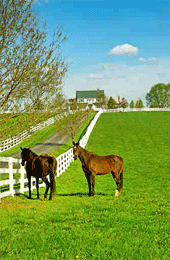The World's Largest Equestrian Real Estate Website. Founded in 2005.

Hawaii is not only famous for its stunning beaches, lush landscapes, and vibrant culture. Beneath the sun and surf, exists a tight-knit equestrian community of horse farms, equestrian estates, and ranches that adds another layer of beauty and diversity to the islands.
Hawaii's horse population includes over 5,600 horses with a small herd of wild horses on the island of Hawai’i. Horses, in their multifaceted roles, contribute not only to the cultural richness of Hawaii but also play a vital part in diversifying and sustaining the state's economy. As of 2022, Hawaii’s GDP reached $75.3 billion with tourism contributing about a quarter of the GDP.
The History of Horses in Hawaii
Horses have a long and fascinating history in Hawaii. The first horses arrived on the islands in the late 18th century, brought by explorers and settlers. These animals soon became an integral part of Hawaiian culture and daily life, playing a significant role in agriculture, transportation, and leisure activities.
As the islands developed, horses adapted to the unique Hawaiian environment, leading to the creation of the Paniolo (Hawaiian cowboy) culture. The Paniolo traditions of cattle ranching, roping, and horsemanship remain alive in Hawaii today, giving the islands a distinctive Western flair that stands in contrast to its tropical surroundings.
The Current Horse Population
While the majority of horses in Hawaii are used for recreational purposes, including trail riding, rodeo events, and competitive sports like polo, there are still many working horses on the islands. These animals continue to contribute to the ranching and agricultural traditions of Hawaii, often in remote areas like Waimea on the Big Island.
Community and Culture
One of the standout historic ranching sites is the Pukalani Stables, home to the Paniolo Heritage Center and managed by the Paniolo Perservation Society, which celebrates the Paniolo culture and showcases local horsemanship.
Challenges and Conservation Efforts
While Hawaii's horse community is rich in history, it faces its fair share of challenges. Maintaining and caring for horses in a tropical environment can be demanding due to the high cost of feed and the difficulties of managing grazing and water supply. Furthermore, land development and urbanization are putting pressure on the available space for horses to roam and graze.
Despite these challenges, there are ongoing conservation efforts and collaborations between equestrians, local communities, and environmental organizations to focus on preserving open spaces, maintaining trails, and promoting responsible horsemanship.
Conclusion
Hawaii's horse population and community are a testament to the islands' diverse and vibrant culture. From the Paniolo traditions rooted in history to the active equestrian enthusiasts of today, horses play a crucial role in connecting Hawaiians to their past and the natural beauty of their home.
If you're looking for horse farms or ranches in Hawaii, feel free to take a look at our current horse properties. Or if you have any questions, please dont' hesitate to contact us or one of our real estate agents.
| Hawaii in Numbers: | |||||||||||||||||||||
|
© 2025. HorseProperties.net®. All rights reserved.